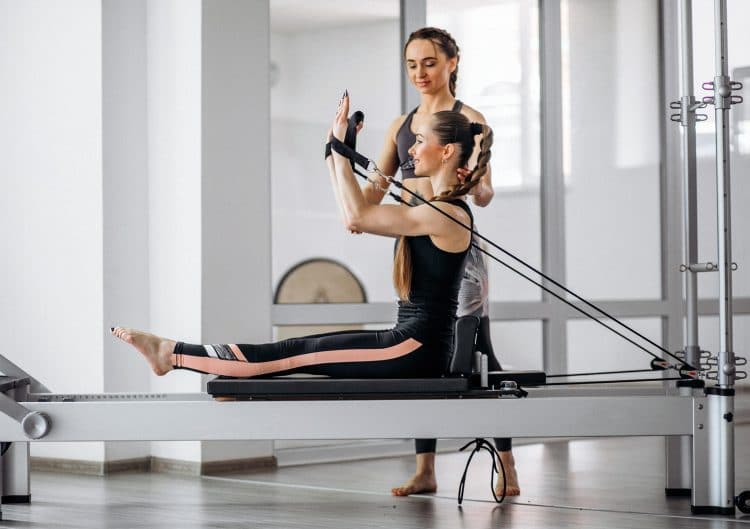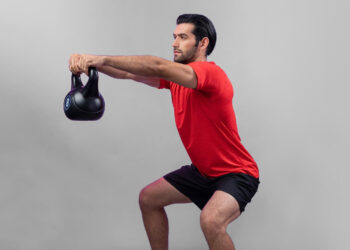A calculator that gives you an approximation of how many calories you burn doing Pilates exercises. The average person will burn 200-250 calories an hour doing Pilates. Calories burned doing Pilates exercises vary depending on factors like sex, age, weight, and muscle mass of an individual. This calculator only gives an estimation that does not regard those variables.
Calories Burned in Group Fitness Classes (Weight: 175lbs)
| MET | 15 mins. | 30 mins. | 45 mins. | 60 mins. | |
|---|---|---|---|---|---|
| Aerobics | 6.6 | 138 | 275 | 413 | 550 |
| Pilates | 3 | 63 | 125 | 188 | 250 |
| Spinning | 7 | 146 | 292 | 438 | 583 |
| Tai Chi | 3 | 63 | 125 | 188 | 250 |
| Zumba | 6.5 | 135 | 271 | 406 | 542 |
| Yoga | 3 | 63 | 125 | 188 | 250 |
| Martial Arts | 10.3 | 215 | 429 | 644 | 858 |
| CrossFit | 5.6 | 117 | 233 | 350 | 467 |
| Bootcamp | 10.1 | 210 | 421 | 631 | 842 |
| Circuit Training | 7.2 | 150 | 300 | 450 | 600 |
| Aqua Aerobics | 3.2 | 67 | 133 | 200 | 267 |
How to use the calculator
This calculator calculates the number of calories burned doing Pilates by simply plugging in 2 values. After plugging in the values, you will get your estimation of the calories expended. This is how you use the calculator.
- Choose the unit of measurement – kilograms or pounds
- Enter your weight and the time spent doing Pilates
- Select for the specific activity you have done and enter time in minutes.
- Hit Calculate
Once you have hit calculate you should see the number of calories that you burned while doing Pilates during the time you have spent doing it.
MET
This calculator uses MET values to calculate this number. A MET (metabolic equivalent) value is a ratio of your resting metabolic rate (RMR) or basal metabolic rate (BMR) relative to your active metabolic rate (AMR). A MET value is given to many physical activities to rate their energy expenditure. The higher the MET, the more calories are expended during that activity.
A MET of 1 is the equivalent to the energy expended at rest when you are not actively digesting or moving. This is also called your resting metabolic rate, or your basal metabolic rate. They are the same, and measure the energy expended when your body is at rest. A task with a MET of 5 uses 5 times as much energy as your resting metabolic rate, or a MET of 1.
The equation also uses the oxygen used by your muscles per kilogram of body weight per minute, which is 3.5 ml. You can find this number yourself by multiplying your weight in kilograms by 3.5. The MET formula uses 3.5 along with your body weight in kilograms and the MET of the physical activity. Then these numbers are divided by 200 to get the number of calories burned per minute doing that activity.
Level Up Your Fitness: Join our 💪 strong community in Fitness Volt Newsletter. Get daily inspiration, expert-backed workouts, nutrition tips, the latest in strength sports, and the support you need to reach your goals. Subscribe for free!
Formula
Total Calories burned in 1 minute = (3.5 x MET x body weight in kg)/200
Examples
A person weighing 200 pounds will burn 286 calories each hour of doing Pilates in general.
- Calories burned (per minute) = (body weight in kg x MET x 3.5) / 200
The formula to calculate the calories burned per minute for a 200-pound person will look like this.
- (90.7185 kg x 3 x 3.5) / 200 = 4.763 calories burned per minute doing Pilates
To calculate the number of calories burned doing an hour of Pilates, you multiply the calories burned per minute by 60 (minutes)
- Calories per hour burned = 4.763 x 60
Calories burned per hour would be 286 calories.
Results
This is how a 200-pound person would burn 286 calories per hour doing Pilates in general using the MET formula for calculating calorie expenditure. A 200-pound person will also burn 4.763 calories per minute doing Pilates.
What is Pilates?

Pilates is a low-impact exercise created in the 20th century by a man named Joseph Pilates. It is an exercise that builds muscle and aids in lower back pain through postural alignment and increasing flexibility. It is also a type of mind-body exercise, like Yoga or Tai-chi. It consists of 45 minutes to hour-long sessions, with or without equipment, and slow, detailed movements tied with breath control. These exercises primarily will target the entire core, strengthening the abdominal muscles, the lower back muscles, the hips, and the thighs.
Level Up Your Fitness: Join our 💪 strong community in Fitness Volt Newsletter. Get daily inspiration, expert-backed workouts, nutrition tips, the latest in strength sports, and the support you need to reach your goals. Subscribe for free!
It is mainly full-body exercise to help you stabilize and strengthen all the muscles in your body, in a low-impact way, building lean muscle. This in turn makes it burn fewer calories than other exercises, so it is not optimal to lose weight.
The benefits of Pilates is that it is easy to get into at a beginner level, but it is not strenuous on the knees or joints, and only strengthens them. Posture is also heavily affected and strengthened through movements like the plank position, which is widely used throughout Pilates.
The fact that it is extremely low impact and is not a difficult resistance training exercise. It will not build a lot of strength like weightlifting but is safer and more appropriate for older or more feeble individuals. Since it works the entire body and increases flexibility and mobility, it is common amongst older, elderly adults, since they most likely need flexibility and mobility the most without impact on the joints and ligaments. High impact exercises like running, and potentially weightlifting can put a lot of stress on the joints if not done correctly, so Pilates is an excellent choice to avoid that.
How great does Pilates burn fat?

Pilates is not a cardiovascular exercise, it primarily is anaerobic and is used to build muscle and gain flexibility and mobility, so it is not a great choice for the person who wants to specifically burn calories with exercise. Pilates involves slow, controlled movements, which are not always great at raising the heart rate. Raising the heart rate is key to good aerobic exercise because the faster your heart is beating, the more calories your body will burn. A Pilates workout is great for assisting in recovery for hard exercise or even mild intensity exercise.
The benefits of other forms of exercise like jump roping, jogging, and swimming are that they are more efficient at specifically burning calories and can assist in you losing weight, but can be higher impact, unlike Pilates.
Pilates is simple and low impact, and movement, in general, is good for recovery from workouts, and it is good for burning a couple of calories. So, if you need something to do on rest days that will not cause you to become sore or tire out your muscles for your next workout, but can aid in mobility and recovery, then Pilates is a great aid for that purpose.
The key to helping you lose fat is to eat fewer calories by changing your diet and tweaking your nutrition. Exercising is great for your health and for losing fat. You just need to be in a caloric deficit by eating a healthy diet and doing exercise that burns more calories. This will cause you to lose weight steadily, have a healthier lifestyle, tone muscles, and improve fitness altogether.
This can only be done if enough protein is eaten, and you stay consistent with the healthy diet and exercises you focus on. Practicing Pilates can be a part of a healthy lifestyle that can help burn a couple of extra calories, but mostly to aid in rest and recovery and your overall physical fitness.
Conclusion
Pilates is a low-impact type of mind-body exercise created by Joseph Pilates. It is great for increasing mobility, flexibility, and strength without taxing the joints and without a high risk of injury. It is practiced worldwide and is mainly adopted by the elderly because of its low risk and function of increasing mobility and flexibility. It is extremely practical for people who do not want to risk injury or do strenuous exercise like weightlifting.
Pilates can burn anywhere from 200 to 250 calories per hour for most people. It is as easy as signing up for a class and taking lessons or looking up videos on how to do it online and following along. It is not the greatest exercise to burn calories, unlike cardio, but it is great for enhancing recovery and getting up and moving.
This is great for immediately improving your health and aiding in your weight loss if you are consistent with all the factors of health and weight loss. These factors would be being in a caloric deficit using your diet, having a workout routine that you do daily, and consistency with everything including rest and recovery. That is all you need for successful weight loss.
Using this calculator, you can very easily calculate the number of calories you burn and keep a practice of tracking your calorie expenditure daily. This will all add up and put you on a satisfying road to the life and body you want!
References:
- Pilates, What is Pilates, retrieved Feb 04, 2022
- Jetté, M.; Sidney, K.; Blümchen, G. (1990-08). Metabolic equivalents (METS) in exercise testing, exercise prescription, and evaluation of functional capacity. Clinical Cardiology. 13 (8): 555–565. doi:10.1002/clc.4960130809.
Additional References:
- Compendium of physical activities: Arizona State University
- WHO global recommendations on physical activity for health (updated): https://www.who.int

















